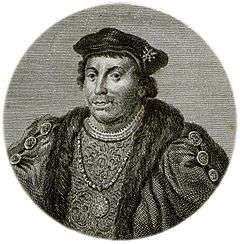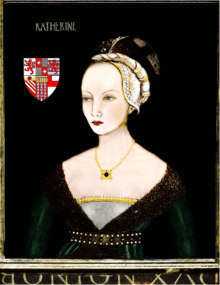Henry Stafford, 2nd Duke of Buckingham
Henry Stafford, 2nd Duke of Buckingham, KG (4 September 1455[1] – 2 November 1483) was an English nobleman known as the namesake of Buckingham's rebellion, a failed but significant collection of uprisings in England and parts of Wales against Richard III of England in October 1483. He is also one of the primary suspects in the disappearance (and presumed murder) of the Princes in the Tower.
Henry Stafford | |
|---|---|
| 2nd Duke of Buckingham | |
 An 18th century illustration of Henry Stafford | |
| Title held | 10 July 1460 – 2 November 1483 |
| Predecessor | Humphrey Stafford, 1st Duke |
| Successor | Title forfeit |
| Born | 4 September 1455 |
| Died | 2 November 1483 (aged 28) |
| Spouse(s) | Catherine Woodville |
| Issue | |
| Father | Humphrey, Earl of Stafford |
| Mother | Margaret Beaufort |

Life

The only son of Humphrey Stafford, Earl of Stafford, Buckingham became Earl of Stafford in 1458 upon his father's death, and was made a ward of King Edward IV of England. He became the Duke of Buckingham at age 4 in 1460 following the death at the Battle of Northampton of his grandfather, Humphrey Stafford, 1st Duke of Buckingham. In February 1466, at age 10, he was married to Catherine Woodville, sister of Edward IV's queen, Elizabeth Woodville, and daughter to Richard Woodville, 1st Earl Rivers.[2] Buckingham and his wife had four children:
- Edward Stafford, 3rd Duke of Buckingham (3 February 1478 – 17 May 1521)
- Elizabeth Stafford, Countess of Sussex (c. 1479 – 11 May 1532)
- Henry Stafford, 3rd Earl of Wiltshire (c. 1479 – 6 April 1523)
- Anne Stafford, Countess of Huntingdon (c. 1483 – 1544)
Upon the death of Edward IV in 1483, Buckingham allied himself to the king's younger brother Richard, Duke of Gloucester, helping him succeed to the throne as Richard III in lieu of Edward's living sons. Becoming disaffected with Richard, Buckingham then joined with Henry Tudor and Tudor's mother, Margaret Beaufort, leading an unsuccessful rebellion in his name. Buckingham was executed for treason by Richard on 2 November 1483: he was beheaded in the courtyard between the Blue Boar Inn and the Saracen's Head Inn (both demolished in the 18th century) in Salisbury market-place. He is believed to have been buried in St Peter's Church in Britford in Wiltshire.[2]
Buckingham's precise motivation has been called "obscure"; he had been treated well by Richard.[3] The traditional naming of the rebellion after him has been labelled a misnomer, with John Morton and Reginald Bray more plausible leaders.[4]
The Princes in the Tower
As Richard III's ally, the plausibility of Buckingham as a suspect depends on the princes having already been dead by the time Stafford was executed in November 1483. It has been suggested that Buckingham had several potential motives.[5] As a descendant of Edward III, through John of Gaunt, 1st Duke of Lancaster and Thomas of Woodstock, 1st Duke of Gloucester on his father's side, as well as through John of Gaunt, 1st Duke of Lancaster through John Beaufort, son of John of Gaunt on his mother's side, Buckingham may have hoped to accede to the throne himself in due course; alternatively, he may have been acting on behalf of a third party.
Some, notably Paul Murray Kendall,[5] regard Buckingham as the likeliest suspect: his execution, after he had rebelled against Richard in October 1483, might signify that he and the king had fallen out; Alison Weir takes this as a sign that Richard had murdered the princes without Buckingham's knowledge and Buckingham had been shocked by it.[6] A contemporary Portuguese document suggests Buckingham as the guilty party, stating "...and after the passing away of king Edward in the year of 83, another one of his brothers, the Duke of Gloucester, had in his power the Prince of Wales and the Duke of York, the young sons of the said king his brother, and turned them to the Duke of Buckingham, under whose custody the said Princes were starved to death."[7] A document dated some decades after the disappearance was found within the archives of the College of Arms in London in 1980; this stated that the murder "be the vise of the Duke of Buckingham".[8] This led Michael Bennett to suggest that possibly some of Richard's prominent supporters, Buckingham and Tyrell, murdered the princes on their own initiative without waiting for Richard's orders. Bennett noted in support of this theory: "After the King's departure Buckingham was in effective command in the capital, and it is known that when the two men met a month later there was an unholy row between them."[9]
Buckingham is the only person to be named as responsible in a contemporary chronicle other than Richard himself. However, for two reasons he is unlikely to have acted alone. First of all, if he were guilty of acting without Richard's orders it is extremely surprising that Richard did not lay the blame for the princes' murder on Buckingham after Buckingham was disgraced and executed, especially as Richard could potentially have cleared his own name by doing so.[10] Secondly, it is likely he would have required Richard's help to gain access to the princes, under close guard in the Tower of London,[11] although Kendall argued as Constable of England, he might have been exempt from this ruling.[12] As a result, although it is extremely possible that he was implicated in the decision to murder them, the hypothesis that he acted without Richard's knowledge is not widely accepted by historians.[10][13] While Jeremy Potter suggested that Richard would have kept silent had Buckingham been guilty because nobody would have believed Richard was not party to the crime,[14] he further notes that "Historians are agreed that Buckingham would never have dared to act without Richard's complicity, or at least, connivance".[15] However, Potter also hypothesised that perhaps Buckingham was fantasising about seizing the crown himself at this point and saw the murder of the princes as a first step to achieving this goal.[15] This theory formed the basis of Sharon Penman's historical novel, The Sunne in Splendour.[16]
In fiction
Buckingham is among the major characters featured in William Shakespeare's play Richard III, which portrays him as a man openly allying with Richard III in his schemes — until he is ordered to kill the Princes in the Tower. In Colley Cibber's 1699 adaptation of Shakespeare's play, he is the subject of the legendary line "Off with his head! So much for Buckingham!"
Buckingham is depicted as a supporting character in Philippa Gregory's 2009 historical novel The White Queen (2009). He is depicted as the murderer of the Princes in the Tower in Sharon Kay Penman's 1982 debut novel The Sunne in Splendour.
He is the major character and storyteller in Isolde Martyn's historical novel The Devil in Ermine (2013), which deals with the events of 1483.
He is a central character in Susan Higginbotham's historical fiction novel, The Stolen Crown (2010), which deals with his associations with King Edward IV and King Richard III.
Henry Stafford is the lead character in J.P. Reedman's A Man Who Would be King (2017) which tells his story from his own first person viewpoint, and portrays him as desiring the throne for himself.
References
- Davies, C. S. L. "Stafford, Henry, second duke of Buckingham", Oxford Dictionary of National Biography, 22 September 2011. Accessed 4 March 2019.
- Tait, J. (1898). . In Lee, Sidney (ed.). Dictionary of National Biography. 53. London: Smith, Elder & Co.CS1 maint: ref=harv (link)
- Carpenter, Christine (13 November 1997). The Wars of the Roses: Politics and the Constitution in England, C.1437-1509. Cambridge University Press. p. 212. ISBN 978-0-521-31874-7. Retrieved 5 April 2013.
- Fritze, Ronald H.; Baxter Robison, William (2002). Historical dictionary of late medieval England, 1272-1485. Greenwood Publishing Group. p. 77. ISBN 978-0-313-29124-1. Retrieved 5 April 2013.
- Kendall, Paul Murray (1955). Richard III. New York: Norton. pp. 487–489.
- Weir, Alison (2008). The Princes in the Tower. London: Vintage. pp. 151–152.
- Alvaro Lopes de Chaves (ref: Alvaro Lopes de Chaves, Livro de Apontamentos (1438–1489), (Codice 443 da Coleccao Pombalina da B.N.L.), Imprensa Nacional – Casa da Moeda, Lisboa, 1983), private secretary to the Portuguese King Alfonso V.
- College of Arms Collection, Queen Victoria Street, London, manuscript MS 2M6. The entire document containing the reference consists of 126 folios. It appears to have belonged to Christopher Barker whilst he was Suffolk Herald (1514–22), since his name, title, and a sketch of his maternal arms appear on folio. io6r. of the MS.
- Bennett, Michael (1993). The Battle of Bosworth (2nd ed.). Stroud: Alan Sutton. p. 46.
- Cheetham, Antony (1972). The Life and Times of Richard III. London: Weidenfeld & Nicolson. p. 148.
- Weir, Alison (2013). Elizabeth of York: The First Tudor Queen. London: Jonathan Cape. p. 104.
- Kendall, Paul Murray (1955). Richard III. New York: Norton. p. 488.
- Pollard 123–124
- Potter, Jeremy (1983). Good King Richard? An Account of Richard III and his Reputation. London: Constable. p. 134.
- Potter, Jeremy (1983). Good King Richard? An Account of Richard III and his Reputation. London: Constable. p. 135.
- Penman, Sharon (1983). The Sunne in Splendour. London: Macmillan. pp. 884–885.
External links
| Wikisource has the text of the 1911 Encyclopædia Britannica article Buckingham, Henry Stafford, 2nd Duke of. |
- Kingsford, C.L. (1911). "Buckingham, Henry Stafford, 2nd Duke of (1454–1483)". Hugh Chisholm, ed. Encyclopædia Britannica (11th ed.), 4. Cambridge University Press.
- Listed among other members of the Stafford family, with their genealogies clarified
| Honorary titles | ||
|---|---|---|
| Preceded by The Duke of Gloucester |
Lord High Constable 1483 |
Succeeded by Lord Thomas Stanley |
| Peerage of England | ||
| Preceded by Humphrey Stafford |
Duke of Buckingham 1460–1483 |
Vacant Forfeit Title next held by Edward Staffordas duke from 1485 |